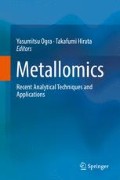Abstract
Nuclear magnetic resonance (NMR) spectroscopy is widely used for the determination of the chemical structure of an organic compound. NMR spectroscopy is theoretically applicable to all metallic elements except cerium. In this chapter, we demonstrate selenium (Se) speciation in animal Se metabolites (selenometabolites) by NMR spectroscopy and review hitherto performed NMR spectroscopic studies of Se detection in biological samples. 77Se, an NMR-active isotope of Se, was directly observed, but its NMR receptivity was lower than its sensitivity in mass spectrometry. However, the use of enriched stable isotope improved the receptivity. Each selenometabolite had its own chemical shift, suggesting that the chemical shift of 77Se could be used as a fingerprint. Indirect measurement by heteronuclear multiple bond correlation (HMBC) spectroscopy with 1H nuclides was also effective for the Se speciation.
Access this chapter
Tax calculation will be finalised at checkout
Purchases are for personal use only
References
Bernhard M, Brinckman FE, Sadler PJ (eds) (1986) The importance of chemical “Speciation” in environmental processes. Springer, Heidelberg
Block E, Glass RS, Jacobsen NE, Johnson S, Kahakachchi C, Kamiński R, Skowrońska A, Boakye HT, Tyson JF, Uden PC (2004) Identification and synthesis of a novel selenium-sulfur amino acid found in selenized yeast: rapid indirect detection NMR methods for characterizing low-level organoselenium compounds in complex matrices. J Agric Food Chem 52:3761–3771
Suzuki KT, Doi C, Suzuki N (2008) Simultaneous tracing of multiple precursors each labeled with a different homo-elemental isotope by speciation analysis: distribution and metabolism of four parenteral selenium sources. Pure Appl Chem 80:2699–2713
Kövér KE, Kumar AA, Rusakov YY, Krivdin LB, Illyés T-Z, Szilágyi L (2011) Experimental and computational studies of n J(77Se, 1H) selenium-proton couplings in selenoglycosides. Magn Reson Chem 49:190–194
Lardon M (1970) Selenium and proton nuclear magnetic resonance measurements on organic selenium compounds. J Am Chem Soc 92:5063–5066
Lu J, Holmgren A (2009) Selenoproteins. J Biol Chem 284:723–727
Szpunar J, Lobinski R (2003) Hyphenated techniques in speciation analysis. Royal Society of Chemistry, Cambridge
Böck A, Flohé L, Köhrle J (2007) Selenoproteins-biochemistry and clinical relevance. Biol Chem 38:985–986
Gammelgaard B, Bendahl L (2004) Selenium speciation in human urine samples by LC- and CE-ICP-MS-separation and identification of selenosugars. J Anal At Spectrom 19:135–142
Suzuki KT, Kurasaki K, Suzuki N (2007) Selenocysteine β-lyase and methylselenol demethylase in the metabolism of Se-methylated selenocompounds into selenide. Biochim Biophys Acta 1770:1053–1061
Weekley CM, Aitken JB, Finney L, Vogt S, Witting PK, Harris HH (2013) Selenium metabolism in cancer cells: the combined application of XAS and XFM techniques to the problem of selenium speciation in biological systems. Nutrients 5:1734–1756
Luthra NP, Dunlap RB, Odom JD (1983) The use of dimethyl selenide as a chemical shift reference in 77Se NMR spectroscopy. J Magn Reson 52:318–322
Schroeder TB, Job C, Brown MF, Glass RS (1995) Indirect detection of selenium-77 in nuclear magnetic resonance spectra of organoselenium compounds. Magn Reson Chem 33:191–195
Mobli M, Morgenstern D, King GF, Alewood PF, Muttenthaler M (2011) Site-specific pK a determination of selenocysteine residues in selenovasopressin by using 77Se NMR spectroscopy. Angew Chem Int Ed 50:11952–11955
Ogra Y, Kitaguchi T, Ishiwata K, Suzuki N, Iwashita Y, Suzuki KT (2007) Identification of selenohomolanthionine in selenium-enriched japanese pungent radish. J Anal At Spectrom 22:1390–1396
Kobayashi Y, Ogra Y, Ishiwata K, Takayama H, Aimi N, Suzuki KT (2002) Selenosugars are key and urinary metabolites for selenium excretion within the required to low-toxic range. Proc Natl Acad Sci U S A 9:15932–15936
Zhang M, Vogel HJ (1994) Two-dimensional NMR studies of selenomethionyl calmodulin. J Mol Biol 239:545–554
Tan K-S, Arnold AP, Rabenstein DL (1988) Selenium-77 nuclear magnetic resonance studies of selenols, diselenides, and selenenyl sulfides. Can J Chem 66:54–60
Foster SJ, Ganther HE (1984) Synthesis of [75Se]trimethylselenonium iodide from [75Se]selenocystine. Anal Biochem 137:205–209
Ogra Y (2008) Integrated strategies for identification of selenometabolites in animal and plant samples. Anal Bioanal Chem 390:1685–1689
Ogra Y, Kitaguchi T, Ishiwata K, Suzuki N, Toida T, Suzuki KT (2009) Speciation of selenomethionine metabolites in wheat germ extract. Metallomics 1:78–86
Ramadan SE, Razak AA, Yousseff YA, Sedky NM (1988) Selenium metabolism in a strain of Fusarium. Biol Trace Elem Res 18:161–170
Reeves MA, Hoffmann PR (2009) The human selenoproteome: recent insights into functions and regulation. Cell Mol Life Sci 66:2457–2478
Suzuki KT, Somekawa L, Kurasaki K, Suzuki N (2006) Simultaneous tracing of 76Se-selenite and 77Se-selenomethionine by absolute labeling and speciation. Toxicol Appl Pharmacol 217:43–50
Schaefer SA, Dong M, Rubenstein RP, Wilkie WA, Bahnson BJ, Thorpe C, Rozovsky S (2013) 77Se enrichment of proteins expands the biological NMR toolbox. J Mol Biol 425:222–231
Suzuki KT, Ogra Y (2002) Metabolic pathway for selenium in the body: speciation by HPLC-ICP MS with enriched Se. Food Addit Contam 19:974–983
Tsuji Y, Suzuki N, Suzuki KT, Ogra Y (2009) Selenium metabolism in rats with long-term ingestion of Se-methylselenocysteine using enriched stable isotopes. J Toxicol Sci 34:191–200
Acknowledgment
This work was supported by JSPS KAKENHI Grants-in-Aid for Scientific Research (Grant Numbers 26460032 (N.S.), 26293030 (Y.O.), 15 K14991 (Y.O.), and 16H05812 (Y.O.)).
Author information
Authors and Affiliations
Corresponding author
Editor information
Editors and Affiliations
Rights and permissions
Copyright information
© 2017 Springer Japan KK
About this chapter
Cite this chapter
Suzuki, N., Ogra, Y. (2017). 77Se NMR Spectroscopy for Speciation Analysis of Selenium Compounds. In: Ogra, Y., Hirata, T. (eds) Metallomics. Springer, Tokyo. https://doi.org/10.1007/978-4-431-56463-8_7
Download citation
DOI: https://doi.org/10.1007/978-4-431-56463-8_7
Published:
Publisher Name: Springer, Tokyo
Print ISBN: 978-4-431-56461-4
Online ISBN: 978-4-431-56463-8
eBook Packages: Biomedical and Life SciencesBiomedical and Life Sciences (R0)

